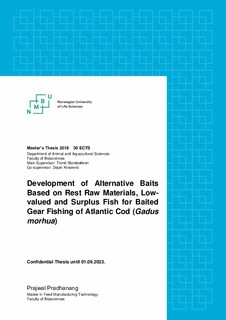| dc.contributor.advisor | Storebakken, Trond | |
| dc.contributor.advisor | Knezevic, Dejan | |
| dc.contributor.author | Pradhanang, Prajwal | |
| dc.coverage.spatial | Norway | nb_NO |
| dc.date.accessioned | 2018-11-21T10:00:12Z | |
| dc.date.available | 2018-11-21T10:00:12Z | |
| dc.date.issued | 2018 | |
| dc.identifier.uri | http://hdl.handle.net/11250/2574073 | |
| dc.description.abstract | The experiment was conducted to develop the alternative baits from low-valued and surplus fish for pot and longline fishing of Atlantic cod. Minced herring and capelin were used to produce baits for pots with increasing level of alginate (2%, 4%, and 6%) and microbial transglutaminase (TG) (0.5%, 1.5% and 2.5%) as the binding agents to attain the optimal handling and water stable baits using a low binder. Alginate-based baits were shaped through stuffing technique while TG-based baits through molding and setting. Alginate supplementation at 4% of the total weight of the bait (4g/100g) gave good handling properties and satisfactory water stability which was easily processed. This level was used to make pot baits from the other two species of fish namely whole minced sprat and minced trimmings of saithe. Four types of baits (5 bait pieces per tank) were subjected to a behavioral study with cod (5 fishes per tank) in three experimental tanks to study their species preference over baits of different species. Response graphs from multivariate principal component analysis of different behavioral patterns showed that herring and sprat gave more attractive baits than capelin and saithe. Herring and capelin baits made with TG did not produce suitable baits. Although, it was compared with alginate-based baits of respective species to study the response difference of binders in cod. There was not observed a substantial difference in behavior of cod in response to the two binders in baits. Industry-processed skin from saithe was used for making baits for longlines, and compared with the baits made from the skin of manually deskinned herring and mackerel. Only the saithe skin was suitable for longline baits owing to its better hooking strength. Behavioral analysis of cod showed poor response to saithe skin bait when compared to highly preferred weak herring and mackerel skin baits. Improvement in taste factor of saithe skin bait was made by either incorporating Ecobait attractants (EA) (5% and 10%) or by coating saithe skin layer over highly preferred herring bait. Response graph and PCA biplot showed improvement in sensory characteristics of these baits compared to pure saithe skin baits. The breaking strength declined linearly with increase in EA concentration while skin coated bait gave the lowest value. All the improvised skin baits showed appreciable hooking stability. | nb_NO |
| dc.language.iso | eng | nb_NO |
| dc.publisher | Norwegian University of Life Sciences, Ås | nb_NO |
| dc.rights | Attribution-NonCommercial-NoDerivatives 4.0 Internasjonal | * |
| dc.rights.uri | http://creativecommons.org/licenses/by-nc-nd/4.0/deed.no | * |
| dc.subject | Atlantic cod | nb_NO |
| dc.subject | Fishing | nb_NO |
| dc.subject | Herring | nb_NO |
| dc.subject | Mackerel | nb_NO |
| dc.subject | Capelin | nb_NO |
| dc.subject | Sprat | nb_NO |
| dc.subject | Saithe | nb_NO |
| dc.title | Development of alternative baits based on rest raw materials, low-valued and surplus fish for baited gear fishing of Atlantic cod (Gadus morhua) | nb_NO |
| dc.type | Master thesis | nb_NO |
| dc.source.pagenumber | 49 | nb_NO |
| dc.description.localcode | M-FT | nb_NO |

